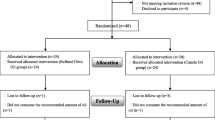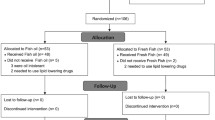Summary
This study investigated whether an ethyl ester preparation of fish oil (ω-3) could normalise raised plasma concentrations of triglycerides, apolipoprotein CIII on apolipoprotein B-containing particles (LP CIII:B) found in patients with recent acute myocardial infarction. We also studied the effect of fish oil on antithrombin III levels. Out of 75 patients with a plasma triglyceride value ≥2.0 mmol/L, 22 normalised their triglycerides during diet and were therefore not randomised. The remaining patients were randomly assigned to 12 weeks’ treatment with a daily dose of 4g ω-3 or placebo. Mean plasma triglyceride concentrations were reduced by 24% from 3.10 ± 1.15 (SD) to 2.53 ± 0.94 mmol/L (p < 0.001) on ω-3 (p < 0.001 vs placebo). The reduction was due to decreases in very low density lipoprotein concentrations. Total apolipoprotein CIII decreased significantly. This was due to reductions in LP CIII:non B concentrations, but the ratio LP CIII:non B/LP CIII:B was unaffected because of a slight insignificant decrease in LP CIII:B. The plasma triglyceride decreasing effect of ω-3 could therefore not be due to redistribution of CIII between lipoproteins. Low density lipoprotein (LDL) cholesterol increased significantly with ω-3 by 7%, and anti-thrombin III increased significantly with fish oil.
In conclusion, ω-3 had a moderate plasma triglyceride lowering effect and increased LDL cholesterol slightly, while antithrombin III increased in patients with hypertriglyceridaemia who had recently experienced a myocardial infarction.
Similar content being viewed by others
References
DeWood MA, Spores J, Notske R, et al. Prevalence of total coronary occlusion during the early hours of transmural myocardial infarction. N Engl J Med 1980; 303: 897–902
Wilson RF, Holida MD, White CW Quantitative angiographic morphology of coronary stenoses leading to myocardial infarction or unstable angina. Circulation 1986; 73: 286–93
Assmann G, Schulte H. Relation of high-density lipoprotein cholesterol and triglycerides to incidence of atherosclerotic coronary artery disease (the PROCAM experience). Am J Cardiol 1992; 70: 733–7
Hamsten A, Wiman B, de Faire U, et al. Increased plasma levels of a rapid inhibitor of tissue plasminogen activator in young survivors of myocardial infarction. N Engl J Med 1985; 313: 1558–63
Chivot L, Mainard F, Bigot E, et al. Logistic discriminant analysis of lipids and apolipoproteins in a population of coronary bypass patients and the significance of apolipoproteins C-III and E. Atherosclerosis 1990; 82: 205–11
Recommendations of the European Atherosclerosis Society prepared by the international task force for prevention of coronary heart disease. Prevention of coronary heart disease: Scientific background and new clinical guidelines. Nutr Metabol Cardiovasc Dis 1992; 2: 113–56
Israel DH, Gorlin R. Fish oils in the prevention of atherosclerosis. J Am Coll Cardiol 1992; 19: 174–85
Harris WS. Fish oils and plasma lipid and lipoprotein metabolism in humans: a critical review. J Lipid Res 1989; 30: 785–807
Mehta J, Lawson D, Saldeen T. Reduction in plasminogen activator inhibitor-1 (PAI-1) with omega-3 polyunsaturated fatty acid (PUFA) intake. Am Heart J 1988; 116: 1201–6
Möller JM, Svaneborg N, Lervang H-H, et al. The acute effect of a single very high dose of N-3 fatty acids on coagulation and fibrinolysis. Thromb Res 1992; 67: 569–77
Mölgaard J, von Schenck H, Olsson AG. Effect of simvastatin on plasma lipid, lipoprotein and apolipoprotein concentrations in hypercholesterolaemia. Eur Heart J 1988; 9: 541–51
Wallentin L, Sundin B. HDL2 and HDL3 lipid levels in coronary artery disease. Atherosclerosis 1985; 59: 131–6
Kane JW, Gowland G. A method for the identification of apolipoprotein E isoforms employing chemical precipitation and flat bed isoelectric focusing in agarose. Ann Clin Biochem 1986; 23: 509–13
Declerck PJ, Alessi MC, Verstreken M, et al. Measurement of plasminogen activator inhibitor 1 in biological fluids with a murine monoclonal antibody-based enzyme-linked immunosorbent assay. Blood 1988; 71: 220–5
Phillipson BE, Rothrock DW, Connor WE, et al. Reduction of plasma lipids, lipoproteins, and apoproteins by dietary fish oils in patients with hypertriglyceridemia. N Engl J Med 1985; 312: 1210–6
Davidson MH, Burns JH, Subbaiah PV, et al. Marine oil capsule therapy for the treatment of hyperlipidaemia. Arch Intern Med 1991; 151: 1732–40
Nestel PJ, Connor WE, Reardon MR, et al. Suppression by diets rich in fish oil of very low density lipoprotein production in man. J Clin Invest 1984; 74: 72–89
Wang C-S, McConathy WC, Kloer HU, et al. Modulation of lipoprotein lipase activity by apolipoproteins. Effects of apolipoprotein C-III. J Clin Invest 1985; 75: 384–90
Blankenhorn DH, Alaupovic P, Wickham E, et al. Prediction of angiographic change in native human coronary arteries and aortocoronary bypass grafts: lipid and non-lipid factors. Circulation 1990; 81: 470–6
Boberg M, Pollare T, Siegbahn A, et al. Supplementation with n-3-fatty acids reduces triglycerides but increases PAI-1 in non-insulin-dependent diabetes mellitus. Eur J Clin Invest 1992; 22: 645–50
Author information
Authors and Affiliations
Rights and permissions
About this article
Cite this article
Swahn, E., von Schenck, H. & Olsson, A.G. Omega- 3 Ethyl Ester Concentrate Decreases Total Apolipoprotein CIII and Increases Antithrombin III in Postmyocardial Infarction Patients. Clin. Drug Investig. 15, 473–482 (1998). https://doi.org/10.2165/00044011-199815060-00003
Published:
Issue Date:
DOI: https://doi.org/10.2165/00044011-199815060-00003




